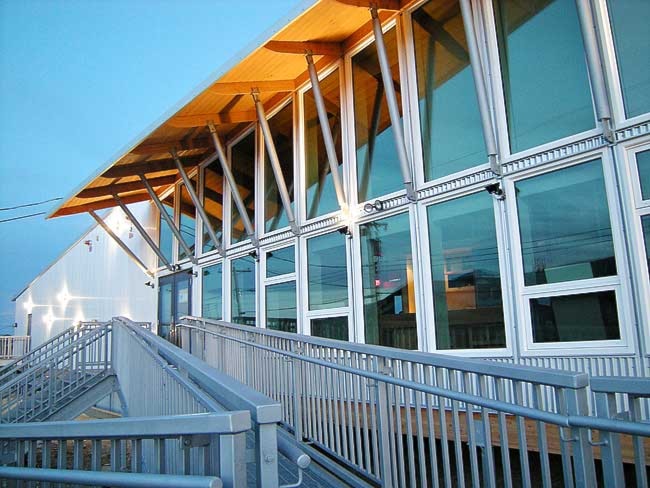Building the John Tizya Cultural Centre in remote Old Crow wasn’t easy.
Without a winter road, all the building materials had to be flown in on a passenger plane.
Everything had to fit through a 1.2- by 2.1-metre-wide door, said architect Antonio Zedda, whose Kobayashi+Zedda Architects designed the building.
It was built from prefabricated panels.
Manufactured in a factory in Delta, BC, they were cut precisely, numbered, taken apart and shipped up north.
“The guys were basically putting together a kit of parts,” said Zedda.
At $1 a pound for shipping, the weight of the building was a big consideration.
Instead of drywall, half of the interior walls are made of translucent Fiberglas panels.
Not only were they much lighter than drywall, but they also provided an interesting architectural feature, said Zedda
The cultural centre was built in 2009, but just last month Kobayashi+Zedda were honoured with a special jury award for innovation from the Royal Architectural Institute of Canada and the Architectural institute of BC for their design.
“It’s a really nice space to work in,” said Megan Williams, the heritage Manager for the Vuntut Gwitch’in government, which owns the building. “It has a lot of natural light, there’s lots of windows and it’s right by the river.
“People bring family here when they come to visit.”
Built on the site of where John Tizya’s cabin once stood - one of the first permanent structures built in Old Crow - the cultural centre’s foundation reaches right down into the permafrost.
“In the summer there is a layer that becomes thawed so we dug all that out and when we got to the permafrost level they put pads down at that level then put steel posts extending to those pads all the way up,” said Zedda. “The foundation is basically sitting on frozen ice, and the steel is just sticking up out of the ground.”
It’s a “tricky” process, he said.
The work has to be done quickly to keep the ground from thawing.
The foundation was backfilled with additional material to provide more insulation, and the temperature of the permafrost layer is constantly monitored.
So far it’s stayed stable, said Zedda, but that might not last.
“We don’t really know what’s going to happen in 50 years, he said. “Who knows if that permafrost can maintain that temperature as the climate gets warmer.”
Just in case, it’s designed to shift.
The building can be adjusted by up to four inches.
While the cultural centre’s foundation is built on ice, the roof is made for the sun.
A bank of solar panels generated electricity that feeds directly into the Old Crow power grid - a first for the Yukon.
“It goes back into the grid and then the building pulls out as much as it needs,” said Zedda.
The rest of the town’s power comes from diesel generators.
At the time the cultural centre was built oil was around $140 a barrel.
“When our engineer took a look at the scenario in Old Crow he came back and said, ‘This is one place where doing photo voltaic (solar energy) actually makes a lot of sense.’ You can actually do it for less cost than burning oil and creating electricity.”
While it doubles as a solar power plant, the building is first and foremost the community’s cultural centre.
“This was a way to really communicate what the Vuntut Gwitch’in are all about,” said Williams.
The community worked closely with consultants from Parks Canada to design displays that tell the story of the region and its people.
“It’s a building where you see a lot of community members,” said Williams. “We’ve got a resource library here, and there’s public computers.”
The displays themselves are on wheels so they can be slid out of the way to accommodate workshops - everything from traditional tanning demonstrations to multimedia tutorials.
It’s also used by Parks Canada as the visitor centre for the Vuntut National Park.
“It’s typical of fly-in communities that, whenever anything is built, it’s trying to do a lot of different things at once,” said Zedda.
According to Williams it’s been very successful doing that.
There were some compromises, she said.
“But I think it was a pretty good representation of what was expected.”
Contact Josh Kerr at
joshk@yukon-news.com
